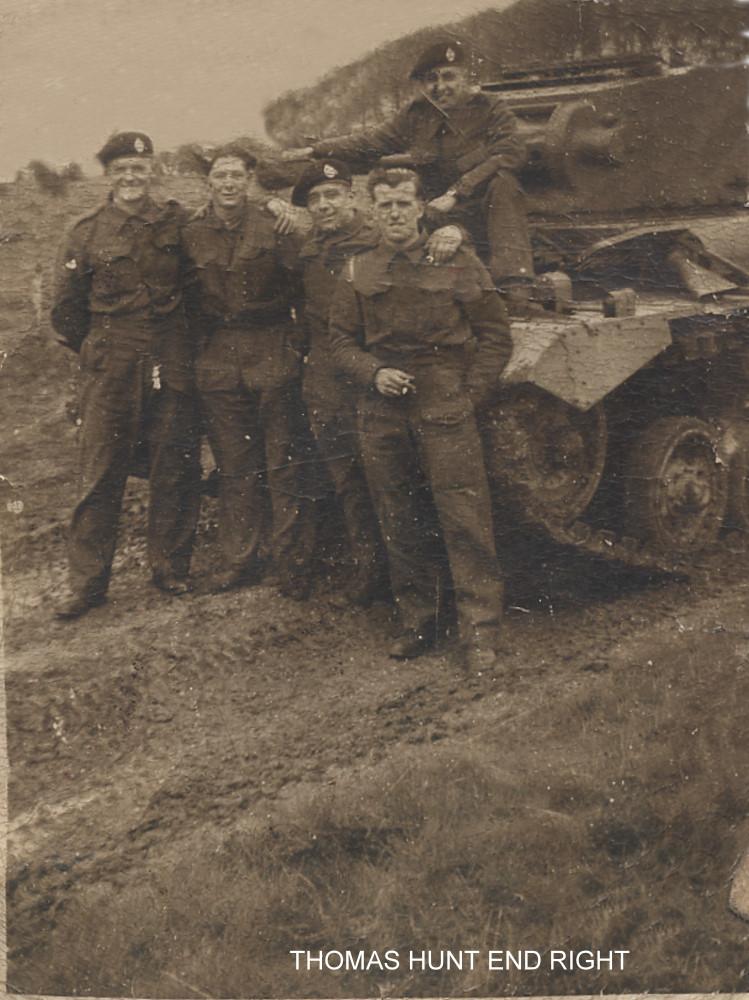Wigan Album
HUNT family
9 Comments
Photo: RON HUNT
Item #: 26437
Facinating shot Ron. Tell us more.
Well Gary I don't know to much about my dad's army life. I was born just after the war and all my mates' dad's had been on the forces so then it was no BIG DEAL and I wasn't interested anyway.. It's only in later life, when they aren't here anymore, that you wished you had asked more questions. I know he was in the INNS OF COURT REGIMENT' I still have his cap badge.. He was a Tank Commander/Instructor. I know he was stationed at TIDWORTH near Salisbury, and BOVINGTON, near Lullworth Cove, There is a Tank Museum there now. His claim to fame was he played football for the army at St.James Park Newcastle with Les Cocker, who at one time was trainer at Leeds United and was England trainer when they won the Word Cup. Also Richard Greene ( Robin Hood) was his mate and in the same tank crew at one time.
I can remember him saying that the German TIGER tank was far superior than our British tanks and you could fire a shell at them and it would just bounce off. That wouldn't have given you much encouragement...
Thank you Ron. I know what you mean about not asking enough questions.Those tank tracks tell a tale.Not to mention the faces of those brave men.
Extremely interesting Ron. I remember being in my schoolmate's house, on Warrington Road, Spring View, towards the latter end of May, 1944. It was pouring with rain. This convoy of army vehicles, including many tank transporters, Lorries loaded with troops, and also towing field guns. The convoy was travelling south, towards Warrington. It took well over twenty four hours for the convoy to pass. It wasn't until the day after the 6th, June, that we realized what it was all for. I was ten years of age at that time.
"Poised, on the left flank of the British invasion beaches - 21st Panzer Division; an old adversary from the desert war. Can they be kept out of action? They are known to be east of the River Orne. What if we could destroy all the bridges, early in the day, surely that would help?
Relying on air attack is uncertain. These bridges must be blown and the experts are available - enter the Royal Engineers. But how to get them there? This is, after all, enemy territory so they will need to move fast, and require protection. The problem was handed to an armoured car regiment, the Inns of Court. This is what happened.
C Squadron, the Inns of Court was specially organised on a 'half-troop' basis. That is 12 groups, each with one Daimler Dingo scout car and one Daimler armoured car. Nine of these groups would each escort a Royal Engineer half-track carrying the explosive charges.
The idea was to land this force on Juno beach from two landing craft, race inland and spread out, each with a bridge as their target. But we all know about the best-laid plans…
As the two landing craft approached the beach one of them struck two mines and sank. Damage was not serious but it would be six hours before those vehicles could be unloaded. Meanwhile the others landed and, having cleared the beach, with the loss of one Dingo on a mine, their troubles began. Another car was knocked out by a British tank but, the further they went the more opposition they met and it soon became clear that they would not reach the bridges that day.
Day two proved even worse; reorganising for a second attempt one troop halted at a location known as Jerusalem Crossroads where, despite showing agreed visual signs, they were attacked by USAF Thunderbolts and the explosive filled half-track blown apart, taking most of the nearby buildings and other vehicles with it.
The survivors tried again on the third day but it was too late. German forces were counter-attacking and it was all the armoured cars could do to keep out of the way of major tank battles.
In the end none of the bridges were destroyed and, despite a regimental legend that one half-troop got nearly all the way to Paris, what was left of the Squadron joined in basic reconnaissance duties until the rest of the regiment arrived, later in the month."
The car lost after clearing the beach was actually hit by a Canadian tank and not a British one. A crew from C Squadron of the Inns used at least one captured German officer as a human shield, this happened at Cristot on the 8th of June. Three Canadian soldiers were shot as a reprisal later on.
I remember my dad saying he went on a course at the Daimler factory, which made Armourd Cars I was fascinated by the fact that he said they had a "FLUID FLY WHEEL"??? and you could put them in reverse from a forward gear and they would go as fast backwards as forwards
Fluid flywheels by Daimler were first used on London Buses in the 1930's due to the heavy load on the gear changes in everyday use.
The tank is a Valentine tank probably a mk 2 or 4, with a 4omm 2 pdr gun
Hey Richard you must know your tanks<g>